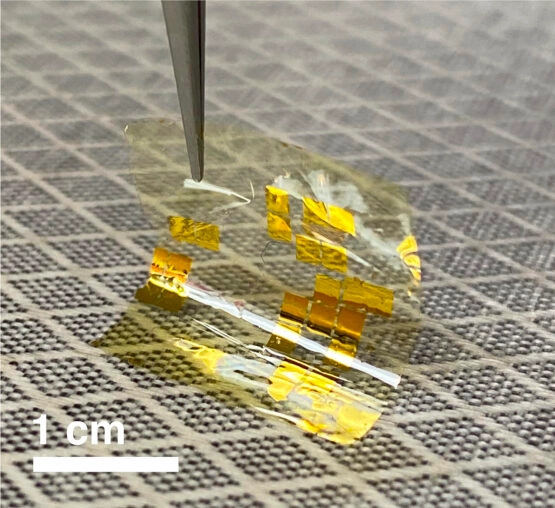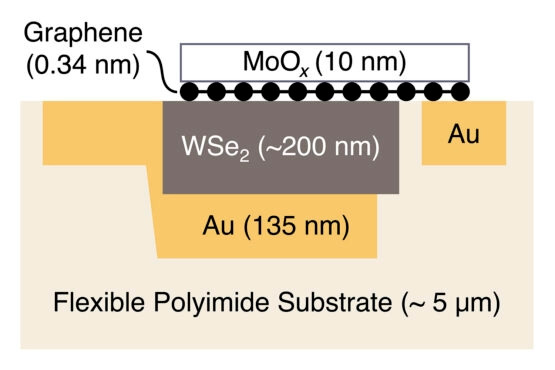创新背景
在太阳能工程领域,一场制造薄而灵活的太阳能电池板的竞赛正在进行中。工程师们设想它们应用于移动应用,从自供电的可穿戴设备和传感器到轻型飞机和电动汽车。这些过渡金属二卤族化合物(简称TMD)的主要好处之一是,与其他太阳能材料相比,它们吸收了超高水平的照射到其表面的阳光。
创新过程
斯坦福大学电气工程博士库沙·纳西里·纳齐夫(Koosha Nassiri Nazif)发表了一项研究:想象一下,一架自动驾驶无人机,它的机翼上有一块比纸张薄15倍的太阳能电池板,为自己提供动力。
寻找新材料是必要的,因为太阳能材料的王者——硅,对于柔性、轻量和高功率突出的应用来说,过于笨重、笨重和刚性,比如可穿戴设备和传感器,或者航空航天和电动汽车。
硅目前占太阳能市场的95%,但还远远不够完美。如果要提高效率,还需要寻找轻质、可弯曲,坦率地说更环保的新材料。

虽然TMD前景广阔,但迄今为止的研究实验仍在努力将它们吸收的超过2%的阳光转化为电能。对于硅太阳能电池板,这个数字接近30%。为了得到广泛应用,TMD必须缩小这一差距。
新的斯坦福原型机实现了5.1%的功率转换效率,但预计通过光学和电气优化,他们实际上可以达到27%的效率。这个数字将与当今市场上最好的太阳能电池板(包括硅)相当。
此外,该原型实现了比目前开发的任何TMD大100倍的功率重量比。这个比例对于移动应用很重要,比如无人机、电动汽车以及在移动中为远征设备充电的能力。当考虑到比功率(衡量单位重量太阳能电池的电力输出功率)时,原型机每克产生4.4瓦,这个数字可以与当今的其他薄膜太阳能电池,包括其他实验原型机相竞争。通过优化,研究人员可以将这一关键比例再提高10倍。他们估计TMD电池的实际极限为每克46瓦。
TMD太阳能电池最大的优点是其卓越的薄度,这不仅将材料使用量和成本降至最低,而且使TMD太阳能电池重量轻、灵活,并能够被塑造成不规则的形状——汽车屋顶、飞机机翼或人体。斯坦福大学的研究小组能够制造出只有几百纳米厚的有源阵列。该阵列包括光伏TMD钨双硒化物和由一层只有一个原子厚度的导电石墨烯横跨的金触点。所有这些材料都被夹在柔软的皮肤状聚合物和增强光吸收的抗反射涂层之间。

当TMD单元完全组装完毕时,厚度不到6微米——大约是一个轻量级的办公室垃圾袋的厚度。需要15层才能达到一张纸的厚度。
虽然薄、轻量化和灵活性本身都是非常理想的目标,但TMD也具有其他工程优势。它们长期稳定可靠。与其他薄膜领域的挑战者不同,TMD不含有毒化学物质。它们还具有生物相容性,因此可以用于需要直接接触人体皮肤或组织的可穿戴应用。
阿尔文·道斯(Alwin Daus)和纳西里·纳齐夫(Nassiri Nazif)是这项研究的共同主要作者,他设计了将薄TMD太阳能阵列固定在柔性基板上的转移过程。他说,这项技术挑战相当大。道斯解释说,其中一个步骤是将原子厚度的石墨烯层转移到只有几微米厚的柔性衬底上。进行这项研究时,道斯是斯坦福大学埃里克·波普研究小组的博士后学者。他现在是德国亚琛工业大学的高级研究员。
这种复杂的工艺使得TMD完全嵌入柔性基板,从而获得更大的耐久性。研究人员通过将设备弯曲在一个不到三分之一英寸厚的金属圆柱体上,来测试设备的灵活性和坚固性。
创新价值
TMD长期稳定可靠。与其他薄膜领域的挑战者不同,TMD不含有毒化学物质。它们还具有生物相容性,因此可以用于需要直接接触人体皮肤或组织的可穿戴应用。
创新关键点
斯坦福大学的研究小组制造出只有几百纳米厚的有源阵列。该阵列包括光伏TMD钨双硒化物和由一层只有一个原子厚度的导电石墨烯横跨的金触点。所有这些材料都被夹在柔软的皮肤状聚合物和增强光吸收的抗反射涂层之间。
Innovative development of new ultra-thin photovoltaic materials
Koosha Nassiri Nazif, a PhD in electrical engineering at Stanford University, has published research: Imagine an autonomous drone powered by a solar panel 15 times thinner than paper on its wing.
The search for new materials is necessary because silicon, the king of solar materials, is too bulky, bulky and rigid for applications where flexibility, light weight and high power are prominent, such as wearables and sensors, or aerospace and electric vehicles.
Silicon now accounts for 95% of the solar market, but it is far from perfect. We need new materials that are light, flexible and, frankly, more environmentally friendly, said Krishna Saraswat, a professor of electrical engineering and senior author of the paper.
While TMDS are promising, research experiments to date have struggled to convert more than 2% of the sunlight they absorb into electricity. For silicon solar panels, the figure is closer to 30 percent. To be widely used, TMD must close this gap.
The new Stanford prototypes achieve a power conversion efficiency of 5.1%, but it is expected that with optical and electrical optimization, they can actually achieve 27% efficiency. That number would be on par with the best solar panels on the market today, including silicon.
In addition, the prototype achieves a power-to-weight ratio 100 times greater than any TMD currently developed. This ratio is important for mobile applications, such as drones, electric vehicles, and the ability to charge expeditionary devices on the move. When considering specific power, which measures the electrical output of a solar cell per unit weight, the prototype produces 4.4 watts per gram, a figure that can compete with other thin-film solar cells today, including other experimental prototypes. With optimization, the researchers could increase this critical ratio a further 10 times. They estimate the practical limit of TMD batteries to be 46 watts per gram.
The biggest advantage of TMD solar cells is their remarkable thinness, which not only minimizes material usage and cost, but also allows TMD solar cells to be lightweight, flexible, and able to be molded into irregular shapes -- car roofs, airplane wings, or human bodies. The Stanford team was able to make active arrays that are only a few hundred nanometers thick. The array includes a photovoltaic TMD tungsten diselenide and gold contacts spanned by a layer of conductive graphene just one atom thick. All of these materials are sandwiched between a soft skin-like polymer and an anti-reflective coating that enhances light absorption.
When the TMD unit is fully assembled, it is less than 6 microns thick -- about the thickness of a lightweight office garbage bag. It takes 15 layers to reach the thickness of a sheet of paper.
While thinness, lightness, and flexibility are highly desirable goals in their own right, TMDS also have other engineering advantages. They are stable and reliable for a long time. Unlike other challengers in the film space, TMDS do not contain toxic chemicals. They are also biocompatible, so they can be used in wearable applications that require direct contact with human skin or tissue.
Alwin Daus and Nassiri Nazif, co-lead authors of the study, designed the transfer process for attaching thin TMD solar arrays to flexible substrates. He says the technical challenge is considerable. Dawes explained that one of these steps involves transferring an atom-thick layer of graphene onto a flexible substrate just a few microns thick. Dawes was a postdoctoral scholar in Eric Pope's research group at Stanford University at the time of the study. He is now a senior researcher at RWTH Aachen University in Germany.
This complex process allows the TMD to be fully embedded into the flexible substrate for greater durability. The researchers tested the flexibility and robustness of the device by bending it over a metal cylinder less than a third of an inch thick.
智能推荐
预测模型实现风力发电的最优控制策略,提升输出功率
2022-08-14这项研究使用最先进的基于物理的尾流模型,辅以数据驱动方法,智能实现偏航控制策略,可以增加风力发电厂的输出功率,提供了在高度可变的风能资源下有效控制风力涡轮机的新方法。通过减少尾流损失,该算法可以在未来的风力发电场中使涡轮机更紧密地连接在一起,从而增加风能的功率密度,节省陆地(或海洋)足迹。同时,这种功率密度的增加和足迹的减少有助于实现温室气体减排目标。
涉及学科涉及领域研究方向新型机器算法可预测锂钴氧化物(LCO)电池性能,加快电池开发速度
2022-09-07涉及学科涉及领域研究方向生物技术创新 | 利用生物光伏为小型设备供电
2022-06-30利用藻类的光合作用生成生物光伏进行不间断的光电转化提供电力。
涉及学科涉及领域研究方向2021年CES展会 | 利用阳光和空气制造饮用水的新型水能板
2022-09-08涉及学科涉及领域研究方向